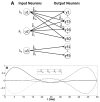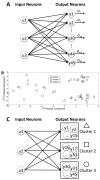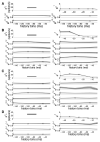Aggregate input-output models of neuronal populations
- PMID: 22552544
- PMCID: PMC4230699
- DOI: 10.1109/TBME.2012.2196699
Aggregate input-output models of neuronal populations
Abstract
An extraordinary amount of electrophysiological data has been collected from various brain nuclei to help us understand how neural activity in one region influences another region. In this paper, we exploit the point process modeling (PPM) framework and describe a method for constructing aggregate input-output (IO) stochastic models that predict spiking activity of a population of neurons in the "output" region as a function of the spiking activity of a population of neurons in the "input" region. We first build PPMs of each output neuron as a function of all input neurons, and then cluster the output neurons using the model parameters. Output neurons that lie within the same cluster have the same functional dependence on the input neurons. We first applied our method to simulated data, and successfully uncovered the predetermined relationship between the two regions. We then applied our method to experimental data to understand the input-output relationship between motor cortical neurons and 1) somatosensory and 2) premotor cortical neurons during a behavioral task. Our aggregate IO models highlighted interesting physiological dependences including relative effects of inhibition/excitation from input neurons and extrinsic factors on output neurons.
Figures








Similar articles
-
Ascertaining neuron importance by information theoretical analysis in motor Brain-Machine Interfaces.Neural Netw. 2009 Jul-Aug;22(5-6):781-90. doi: 10.1016/j.neunet.2009.06.007. Epub 2009 Jun 30. Neural Netw. 2009. PMID: 19615852
-
Neural Representation and Causal Models in Motor Cortex.J Neurosci. 2017 Mar 22;37(12):3413-3424. doi: 10.1523/JNEUROSCI.1000-16.2017. Epub 2017 Feb 20. J Neurosci. 2017. PMID: 28219983 Free PMC article.
-
Task-driven intra- and interarea communications in primate cerebral cortex.Proc Natl Acad Sci U S A. 2015 Apr 14;112(15):4761-6. doi: 10.1073/pnas.1503937112. Epub 2015 Mar 30. Proc Natl Acad Sci U S A. 2015. PMID: 25825731 Free PMC article.
-
Stimulus-driven changes in sensorimotor behavior and neuronal functional connectivity application to brain-machine interfaces and neurorehabilitation.Prog Brain Res. 2011;192:83-102. doi: 10.1016/B978-0-444-53355-5.00006-3. Prog Brain Res. 2011. PMID: 21763520 Review.
-
Modeling the formation process of grouping stimuli sets through cortical columns and microcircuits to feature neurons.Comput Intell Neurosci. 2013;2013:290358. doi: 10.1155/2013/290358. Epub 2013 Nov 28. Comput Intell Neurosci. 2013. PMID: 24369455 Free PMC article. Review.
Cited by
-
Modulations in Oscillatory Activity of Globus Pallidus Internus Neurons During a Directed Hand Movement Task-A Primary Mechanism for Motor Planning.Front Syst Neurosci. 2019 Apr 30;13:15. doi: 10.3389/fnsys.2019.00015. eCollection 2019. Front Syst Neurosci. 2019. PMID: 31133824 Free PMC article.
-
Developing control-theoretic objectives for large-scale brain dynamics and cognitive enhancement.Annu Rev Control. 2022;54:363-376. doi: 10.1016/j.arcontrol.2022.05.001. Epub 2022 Jul 5. Annu Rev Control. 2022. PMID: 38250171 Free PMC article.
-
A systematic approach to selecting task relevant neurons.J Neurosci Methods. 2015 Apr 30;245:156-68. doi: 10.1016/j.jneumeth.2015.02.020. Epub 2015 Mar 3. J Neurosci Methods. 2015. PMID: 25746150 Free PMC article.
-
Neuromorphic algorithms for brain implants: a review.Front Neurosci. 2025 Apr 11;19:1570104. doi: 10.3389/fnins.2025.1570104. eCollection 2025. Front Neurosci. 2025. PMID: 40292025 Free PMC article. Review.
-
Assessing dynamic spectral causality by lagged adaptive directed transfer function and instantaneous effect factor.IEEE Trans Biomed Eng. 2014 Jul;61(7):1979-88. doi: 10.1109/TBME.2014.2311034. IEEE Trans Biomed Eng. 2014. PMID: 24956616 Free PMC article.
References
-
- Nicolelis MAL, Ghazanfar AA, Faggin BM, Votaw S, Oliveira LMO. Reconstructing the engram: Simultaneous, multisite, many single neuron recordings. Neuron. 1997;18(4):529–537. - PubMed
-
- Rubin JE, Terman D. High frequency stimulation of the subthalamic nucleus eliminates pathological thalamic rhythmicity in a computational model. Journal of Computational Neuroscience. 2004;16:211–235. - PubMed

